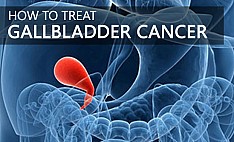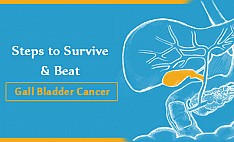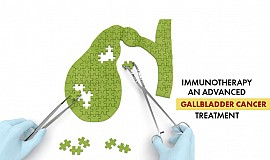About Gall Bladder Cancer:
Gallbladder cancer which begins in the gallbladder is a rare cancer which is more common in women than in men. The gallbladder is a small pear shaped organ located on the right side of the liver. These cancers are of two types-
- Adenocarcinomas: Subtypes include- papillary, nodular, and tubular, depending on the appearance of the tumor cells under the microscope
- Adenoacanthoma: Subtypes include- squamous cell, signet ring cell, and adenosquamous
linkRisk Factors:
The exact cause of the cancer is unknown, however there are few factors associated with it, which include:
- Age: More common in older people
- Gallstones: Swelling of the bladder and gallstones are the most common risk factors of gallbladder cancer (80% chances)
- Family history: According to research people with immediate family members with gallbladder cancer are five times more likely to develop the cancer than people who don’t have
- Smoking and industrial chemicals (metal or rubber industry): Cigarette smoking and certain industrial chemicals increase the gallbladder cancer risk. As these contain nitrosamines which can damage the DNA and increase the cancer risk
- Obesity: Overweight causes changes in the body hormones, especially for women and this increases the cancer risk
- Other factors like bile duct and pancreatic abnormalities, diabetes and diet also play a role in gallbladder cancer
linkSymptoms:
Gallbladder symptoms usually do not cause any symptoms in the early stage. Most of the symptoms happen in the later stage. These include:
- Abdomen pain: Pain on the right side of the abdomen
- Feeling sick: This symptom usually occurs at the later stage of gallbladder cancer
- Jaundice: A condition in which your liver stops working properly or there is a blockage of the bile duct
- Swollen abdomen
- Loss of appetite and weight
- Gallbladder enlargement if your bile duct gets blocked
Gall Bladder Cancer: Stages
Stage 0: The cancer is restricted to the inner wall of gall bladder and has not spread to deeper layers.
Stage I: The cancer has spread into the lamina propria or the muscles of gall bladder but not to lymph nodes or distant sites.
Stage IIA: The tumor has grown beyond the muscular layer into the connective tissue that covers the muscle layer. No spread to lymph nodes or distant sites.
Stage IIB: The cancer has grown into the perimuscular layer on the side of the liver but has not affected the liver. No spread to lymph nodes or distant sites.
Stage IIIA: The cancer has grown beyond the outermost layer of the gall bladder or has grown into the liver or some other organ like stomach, dudoenum, colon, pancreas or bile duct. No spread to lymph nodes or distant sites.
Stage IIIB: The tumor has grown through the gall bladder wall to some other organ like liver and along with no more than 3 lymph nodes. No spread to distant sites.
Stage IVA: The cancer has extended into the portal vein or hepatic artery or 2 or more structure outside of the liver. Involvement of 3 or less lymph nodes. No spread to distant sites.
Stage IVB: The primary tumor may or may not have extended outside of the gall bladder and it may have advanced to 4 or more lymph nodes. Or the cancer may have spread to nearby organs like liver, peritoneum, or lungs while the primary tumor may or may not be confined to the gall bladder.
linkDiagnosis:
Before any tests are conducted, complete physical examination of the patient is done. Later, the following tests are done to confirm the presence of cancer cells.
- Ultrasonography (US): This test helps differentiate people who have pain because of gallstones or gallbladder cancer. This test also helps to detect if the cancer has spread to the other parts of the body
- Computed tomography (CT): This test can help find out the growth of cancer inside the gallbladder or the growth outside the gallbladder. It also helps find out if the cancer has spread to the bile duct, lymph nodes or to the liver
- Magnetic resonance imaging (MRI): This test is good if you are planning to do surgery, as this imaging test allows examining of surrounding blood vessels and the bile duct passage
- Cholangiography: It is done either through the skin or the stomach. A technique that allows HCPs to not only establish a diagnosis, but to locate the blockage and place a stent through the blockage to help alleviate the blockage
- Routine blood work may also help your physician determine whether there is a blockage in the bile ducts and how well the liver is functioning. There are tumor markers which can be tested for in the blood, such as CEA and CA 19-9. These markers can be elevated in cancer of the gallbladder, but are not good for diagnosis as they are non-specific and other conditions can cause them to be elevated
linkPrevention:
There is no way to prevent gallbladder cancer risk; however you can reduce the risk by:
- Maintaining a healthy weight by including fruits and vegetables in the diet and by regular exercising
- Gallbladder removal for people who have gallstones
- Preventing hepatitis may reduce the bile duct cancer risk and this can be done by safe sex, avoiding contacts with used needles etc
linkTreatment:
The extent of a gall bladder cancer is significant in determining the gall bladder cancer treatment options. For the gall bladder cancer treatment options, the doctors generally divide the cancer in resectable and unresectable cancers. Treatment options depends on several factors such as the type and stage of cancer, the side effects and the overall health and preferences.
The gallbladder cancer treatment depends on several factors such as:
1. The stage of the cancer
2. The side effects of the treatment
3. The overall health
4. The chances of curing the disease, extending life, or relieving symptoms.
Medicines used for gallbladder cancer treatment works on the principle of Immunotherapy, a therapy that fights cancer by using the body’s immune system. Because of the immune system's unique properties, this therapy holds great potential compared to the current treatment approaches to fight cancer more effectively, to offer longer-term protection against the disease with fewer side effects. At Cancer Healer Center we use Cancer Healer Therapy which is based on Immunotherapy. The gall bladder cancer treatment types vary depending on the type and stage of the gallbladder cancer.
Gall bladder can be treated with one or more treatments such as surgery, chemotherapy and radiation therapy. If detected at an early stage, the chances of gallbladder cancer treatment being effective are extremely high. However, it’s important to discuss all gallbladder cancer treatment options, including their goals and possible side effects, with your doctors to help make the decision that best fits your needs.
I L.Choudhary patient of TCC urinary bladder under treatment from December 2017 and Cancer healer center Chandigarh and cured as per PET CT Scan report dated 20-10-2018 by grace of God. I am thankful to Dr. Krishna and his team at Chandigarh center for their efforts to boost my moral according







